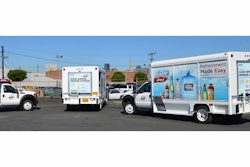
Truckload carriers continue to innovate to remain profitable, particularly through service diversification and driver retention, according to TMW Systems’ first annual Transportation & Logistics Study – North America For-Hire Truckload Carrier Benchmarking Survey, released today. Truckload carriers that are diversifying their businesses are adding new higher margin services, including brokerage, logistics, LTL to TL consolidation, dedicated services and intermodal services. Those looking to expand are exploring dedicated services first (27%), followed by brokerage services (21%). The majority of them are working on an accelerated schedule, within a one year time frame.
“With increasing regulations, driver constraints and rising costs of equipment and labor, truckload companies are struggling to stay profitable,” said David Wangler, TMW Systems president. “Companies that are increasing profit margins are diversifying and using technology to drive optimization. Metrics-based management is critical to staying competitive. Progressive truckload carriers have already invested in and deployed these technologies to improve asset utilization and are reporting positive results.”
Driver Turnover
The survey revealed the most important factor in retaining drivers: driver miles. Turnover and utilization are directly tied to driver pay miles. Turnover rates closely follow driver revenue miles per week. Companies whose drivers log the most hours have the lowest turnover rates, indicating the higher the utilization, the lower the turnover. Trucks sitting empty not only impact financial performance but also have a devastating effect on driver morale and overall retention. While home time is important, it is quantitatively clear that drivers need that time away from home to be consistently productive.
Operating Ratio (OR)
Government regulations, driver constraints and increasing costs of equipment and labor are among the factors keeping Operating Ratios (OR) high. Seventy-one percent of survey respondents report 94% or higher OR, whereas the industry’s best performers achieve an OR of less than 90%. Survey results uncovered a strong correlation (~75%) between utilization and OR, so it’s clear why this issue consistently rises to the top of fleet priorities.
Asset Utilization
Survey respondents also shared the biggest challenge over the next one to two years: maximizing asset utilization (24%). The average utilization (revenue miles per seated truck per week) is 2,230. No company with fewer than 2,000 revenue miles per truck per week achieved better than 97% OR.
Fleet Down Time
Fleet down time continues to pose a challenge. Respondents reported 5.64% of their tractor fleets have been down in the last 12 months, an alarming figure, as anything over 5% is typically viewed as unacceptable. The average age of fleet at 44 months is older than ideal, potentially resulting in higher unscheduled breakdowns negatively impacting asset utilization.
About the Survey
TMW’s 2013 Transportation & Logistics Study was developed from a benchmarking survey conducted online from October 24 through November 16, 2012. Business leaders from more than 60 national transportation firms with more than 21,000 units provided TMW Systems with detailed financial and operational metrics and opinions on the industry’s leading issues right now. This inaugural survey focuses on one segment of the transportation market, over-the-road long haul truckload carriers.
This study represents the industry’s most unique performance scorecard for North America truckload carriers, and captures and analyzes key trends, challenges and opportunities facing for-hire carriers. A TMW Systems client shared, “Having access to industry metrics in context saves us an inordinate amount of time and analysis. We don’t have to discover the correlations on our own.”



















